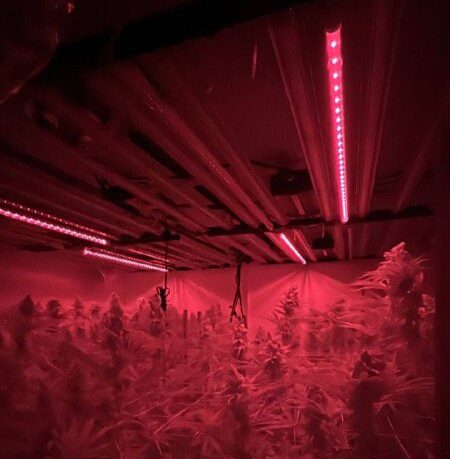1. Introduction to Far Red Light
1.1 What is Far Red Light?
Far red light refers to the light wavelength between 700 and 750 nanometers. It’s just beyond the visible red spectrum and sits on the edge of infrared, which is invisible to the human eye. While we might not see it, plants certainly do — and they love it.
1.2 Where Does It Fall on the Light Spectrum?
Far red lives in the sliver of the spectrum right after traditional red light (around 660nm). It’s often overlooked but plays a huge role in plant development, especially in flowering and stretching.
1.3 Difference Between Red and Far Red Light
Red light promotes compact, leafy growth, while far red encourages elongation and flowering. When used together strategically, they can create powerful effects on plant morphology and productivity.

2. The Science Behind Far Red Light in Plant Growth
2.1 How Plants Perceive Light
Plants don’t “see” like us, but they sense light using photoreceptors. These receptors interpret light quality, intensity, duration, and direction to make growth decisions.
2.2 The Role of Phytochromes
The phytochrome system is a key player. It exists in two states:
Pr (inactive) – absorbs red light
Pfr (active) – absorbs far red light
Plants use this system like a light switch, controlling germination, flowering, and stem elongation.
2.3 Photomorphogenesis Explained
Photomorphogenesis is the process by which plants change their shape in response to light. Far red is critical in this, signaling plants to stretch, branch, or bloom based on the spectrum they receive.

3. Benefits of Far Red Light in Cultivation
3.1 Accelerated Flowering and Stretching
Need faster flowering cycles? Far red has your back. It helps trigger early and stronger flowering, which is a huge plus for commercial growers chasing quick turnarounds.
3.2 Improved Canopy Penetration
Far red wavelengths penetrate deeper into the canopy than other colors. This means lower leaves and hidden bud sites get more light and grow better.
3.3 Increased Biomass and Yield
Far red light has been shown to increase dry weight and total yield, especially when used during the early flowering stages.
4. Far Red Light in Indoor Grow Setups
4.1 Why Indoor Growers Are Adopting It
Indoor growers love control, and far red gives them just that. With full spectrum LEDs now including far red diodes, it’s easier than ever to optimize every growth stage.
4.2 LED Technology with Far Red Features
Modern grow lights include channels for customizable far red output, allowing cultivators to fine-tune their spectrum and manipulate plant behavior with precision.
4.3 Balancing Spectrum for Maximum Results
Too much far red? Plants might stretch too much. The trick is balancing far red with red and blue wavelengths for optimal morphology.
5. Far Red Light in Greenhouse Cultivation
5.1 Natural Light Supplementation
Greenhouses already have sunlight, but far red can supplement during cloudy days or evening hours, enhancing natural photoperiod responses.
5.2 Boosting Low-Light Performance
Far red helps crops thrive even when the sun isn’t out in full force. It’s particularly useful in winter grows or shady locations.
Integration with Existing Lighting Systems
Retrofit kits and far red supplemental bars make it easy to add far red without overhauling your entire lighting setup.
6. Optimal Usage of Far Red Light
6.1 Best Times to Apply Far Red
Apply far red during:
End of the day to simulate sunset (end-of-day far red)
Flowering stages to trigger reproductive growth
Early veg if you want more stretch or vertical height
6.2 How Much Is Too Much?
Overusing far red can lead to leggy, weak plants. Keep your red:far red ratio in check, ideally around 1:0.5 for balance.
6.3 Strategies for Different Growth Phases
Veg phase: Use sparingly to prevent over-stretching
Flower phase: Increase far red to boost bud formation
Late flower: Dial it back to maintain density
7. Challenges and Myths Around Far Red
7.1 Common Misunderstandings
Many growers think far red = magic. It’s powerful, but not a silver bullet. Without the right spectrum mix, it can backfire.
7.2 Overuse and Stretching Concerns
Yes, too much far red causes stretching. But when used correctly, it creates taller, healthier plants without compromising strength.
7.3 Finding the Sweet Spot
Test and tweak your light recipes. What works for lettuce may not work for cannabis or tomatoes.
8. Far Red Light and Crop Steering
8.1 Spectral Control for Targeted Growth
Crop steering is the art of using inputs — like light spectrum — to influence plant behavior. Far red is an advanced tool in that toolkit.
8.2 Customizing Light Recipes
Tailored light recipes with far red can direct plants toward:
Generative growth (flowers, fruits)
Vegetative growth (stems, leaves)
Conclusion
Far red light isn’t just a trend — it’s a game-changing advancement in both indoor and greenhouse horticulture. From increased yields to faster flowering, this once-overlooked part of the spectrum is proving its worth. By understanding how, when, and why to use it, you can take your grow to the next level — whether you’re in a tent, warehouse, or glasshouse.
